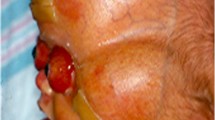Abstract
Fibroblast growth factor receptor mutations cause some of the main short-limb skeletal dysplasias and craniosynostosis syndromes, including achondroplasia, hypochondroplasia, thanatophoric dysplasia, Apert syndrome, Crouzon syndrome, Pfeiffer syndrome, and Jackson-Weiss syndrome. Much work remains to be done in unraveling the pathogenesis of these phenotypes.
Similar content being viewed by others
Author information
Authors and Affiliations
Additional information
Received: 27 November 1995 Accepted: 21 February 1996
Rights and permissions
About this article
Cite this article
Cohen Jr., M. Short-limb skeletal dysplasias and craniosynostosis: what do they have in common?. Pediatric Radiology 27, 442–446 (1997). https://doi.org/10.1007/s002470050165
Issue Date:
DOI: https://doi.org/10.1007/s002470050165




